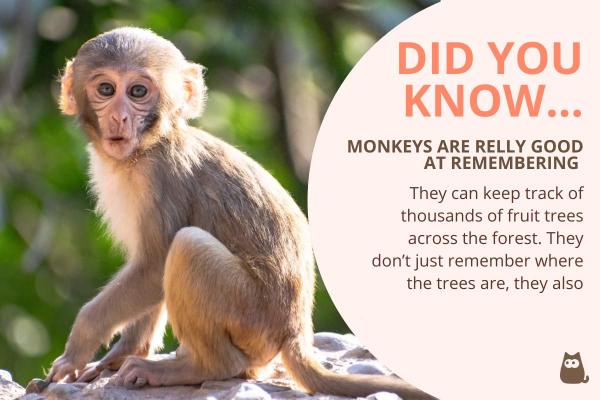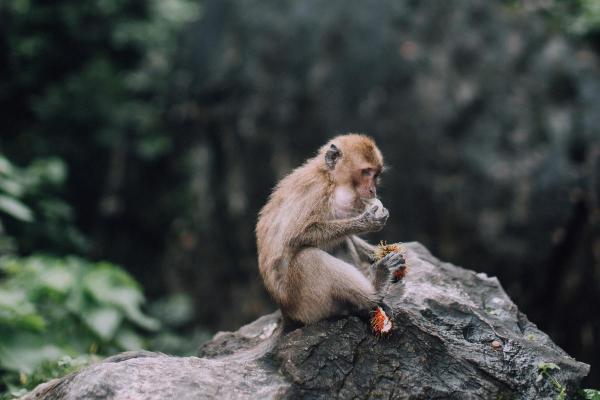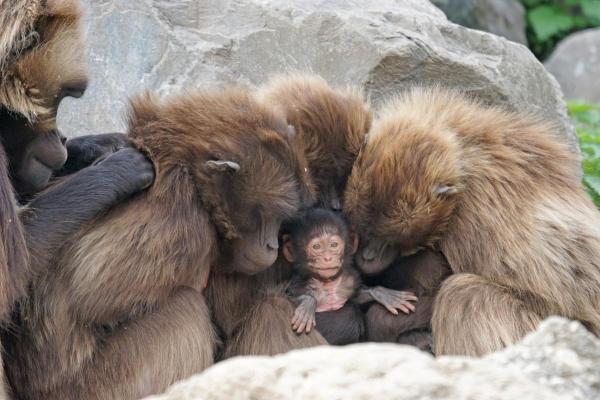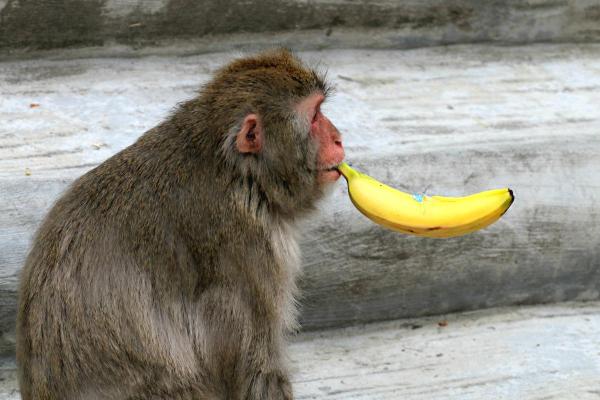10 Fun Monkey Facts


Most people picture monkeys swinging through trees and munching on bananas. It is a fun image, and sometimes true, but there is much more to them. These animals are smart, social, and full of surprises. They solve problems, build strong group bonds, and adapt to all kinds of environments. Monkeys aren’t just fun to watch, they are some of the most interesting mammals out there.
If you’re curious or just love learning new things, here are 10 monkey facts from AnimalWised that might surprise you.
- They’re tool-using masters
- They recognize themselves in mirrors
- They have unique fingerprints
- Their sizes vary greatly
- They have a complex communication system
- Their facial coloration is a form of signaling
- They have advanced mathematical abilities
- They have specialized dietary adaptations
- They have complex social structures
- They strategically deceive others
They’re tool-using masters
Forget what you learned about humans being the only tool users. Monkeys are incredibly skilled with tools. White-faced capuchins (Cebus capucinus) don't just randomly pick up stones, they carefully select harder quartz stones specifically for cracking tough nuts. They even maintain "anvil" sites that get passed down through generations, creating a kind of monkey workshop tradition.
In Thailand, long-tailed macaques (Macaca fascicularis) also use sharp stones to pry open oysters and then teach this technique to their young ones. This sophisticated behavior represents cultural transmission, which is the passing of knowledge from one generation to the next, something we once thought was unique to humans.

They recognize themselves in mirrors
Ever make funny faces in the mirror? Well, great apes do too. Chimpanzees (Pan troglodytes) and orangutans (Pongo species) show clear signs of self-recognition when they see their reflection. They'll use mirrors to check out parts of their bodies they can't normally see and even remove food stuck in their teeth, which is a classic demonstration of self-awareness.
Building on this cognitive foundation, tufted capuchin monkeys (Sapajus apella) can use mirrors as tools to locate hidden food. This sophisticated behavior demonstrates their understanding of spatial relationships and shows how intelligence evolved along different pathways in primate lineages.
They have unique fingerprints
Monkeys have unique fingerprints, just like humans do. Their fingerprints display identical patterns of arches, whorls, and loops that make our own prints individually identifiable. This similarity isn't coincidental but represents convergent evolution, where similar traits develop independently in different species because they serve the same fundamental purpose, better grip and more sensitive touch.
Wildlife forensic experts have documented cases where langur monkey (Semnopithecus) prints were initially confused for human ones at a crime scene in India.
If you enjoy learning about monkey intelligence, you'll be fascinated to discover which primate fathers, along with other remarkable animal dads, show extraordinary parenting skills in our other article.

Their sizes vary greatly
Monkeys show significant size differences. The pygmy marmoset (Cebuella pygmaea) of the Amazon weighs about 100 grams (approximately 0.22 pounds). These small monkeys have large eyes and are suited for life on thin branches. In contrast, male mandrills (Mandrillus sphinx) from Central Africa can weigh around 35 kg (approximately 77 pounds) and have large canine teeth and muscles.
This size difference, with the largest being about 350 times heavier than the smallest, highlights how well monkeys have adapted. Small species can reach food like nectar and insects on small branches, while larger ones can protect their areas and eat tougher foods.
They have a complex communication system
Field researchers in Kenya have documented how vervet monkeys (Chlorocebus pygerythrus) use distinct alarm calls that function almost like words. These aren't random noises, they're specific signals for specific predators. One call means "eagle overhead" and sends the whole group diving into bushes. Another means "snake in the grass," causing them to stand on two legs and scan the ground. A third means "leopard nearby," prompting them to climb high into the trees.
What's particularly fascinating is that baby vervets have to learn these calls, they'll sometimes make mistakes, like sounding the eagle alarm when they see a harmless bird. The adults largely ignore these false alarms, and through this social feedback, the youngsters gradually learn to use the calls correctly. It's a genuine language with actual meanings that develops through social learning.
Did you know that keeping primates requires specialized knowledge and care? Discover the challenges and requirements in our detailed article on monkey guardianship.
Their facial coloration is a form of signaling
The first sight of a male mandrill (Mandrillus sphinx) is not easy to forget. Their blue and red facial markings signal the monkey's status and testosterone levels. A male's colors become more intense as he rises in rank, and they fade if he gets sick or loses his position. This is a natural display of status.
In the misty mountains of China, golden snub-nosed monkeys (Rhinopithecus roxellana) have unusual blue faces. Their skin's structure scatters light to appear blue, similar to why the sky looks blue. This unique appearance helps these monkeys recognize each other in their foggy forest habitat.

They have advanced mathematical abilities
Cognitive studies comparing rhesus macaques (Macaca mulatta) with college students on number memory tasks show surprising results. These monkeys can quickly see a screen with numbers and then accurately recall their positions, often doing better than human participants on these tests.
Researchers believe this ability may have developed because quickly judging amounts in the wild, such as counting predators, food, or group members, could aid survival. While humans have developed different cognitive skills, these monkeys show that "intelligence" is complex and not a simple scale with humans at the top.
They have specialized dietary adaptations
Howler monkeys (Alouatta palliata) in Costa Rica have developed specialized digestive systems. These primates have multi-chambered stomachs, like cows, that can break down toxins in leaves. This allows them to eat food that other animals cannot, reducing competition in their forest homes.
Japanese macaques (Macaca fuscata) offer a well-known example of cultural food innovation. In the 1950s, a young female monkey was seen washing sand off sweet potatoes in a stream. This behavior spread through her group and continues today. Some monkeys even started dipping their food in the ocean, possibly liking the salty taste. This shows how food preparation ideas can spread in monkey groups through watching and learning.
Interested in learning about monkey diets? Check out our article on what these diverse primates eat in the wild.
They have complex social structures
Chimpanzee (Pan troglodytes) social structures show political dynamics similar to human organizations. These societies involve alliances, coalitions, reconciliations, and strategic friendships. The alpha male is often the most socially intelligent, building and keeping a network of supporters, rather than just the strongest.
Long-term studies of olive baboons (Papio anubis) show friendships that last for years. Baboons with strong social bonds have lower stress hormone levels and recover better from injuries. These connections offer grooming, food sharing, and defense during difficult times.

They strategically deceive others
Bornean orangutans (Pongo pygmaeus) in rehabilitation centers sometimes show deceptive behaviors. Some pretend to be stuck or hurt to get attention and treats, then quickly recover. Staff have observed that these orangutans intentionally manipulate their caregivers.
In the wild, tufted capuchins (Sapajus apella) create distractions to steal food. One monkey will act alarmed to make others look away while another takes the food. They show patience and good timing, waiting for the right moment. Some captive monkeys have also learned to open simple locks by watching their caretakers, showing their strong observational learning skills.
Want to help protect these fascinating animals? Learn about the most threatened monkey species and conservation efforts in our related article.

If you want to read similar articles to 10 Fun Monkey Facts, we recommend you visit our Facts about the animal kingdom category.
- Margiotoudi, K., Allritz, M., Bohn, M., & Pulvermüller, F. (2019). Behavioral, neurophysiological, and evolutionary perspectives on uneven fingerprints in primates. Neuroscience & Biobehavioral Reviews, 101, 194-206. https://doi.org/10.1016/j.neubiorev.2019.04.004
- Fischer, J., & Price, T. (2017). Meaning, intention, and inference in primate vocal communication. Neuroscience & Biobehavioral Reviews, 82, 22-31. https://doi.org/10.1016/j.neubiorev.2016.10.014
- Inoue, S., & Matsuzawa, T. (2007). Working memory of numerals in chimpanzees. Current Biology, 17(23), R1004-R1005. https://doi.org/10.1016/j.cub.2007.10.027
- Amato, K. R., & Righini, N. (2015). The howler monkey as a model for exploring host-gut microbiota interactions in primates. In Howler Monkeys (pp. 229-258). Springer. https://doi.org/10.1007/978-1-4939-1957-4_9










